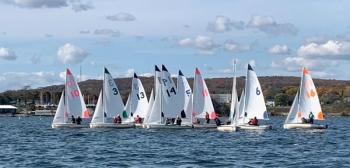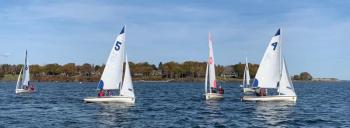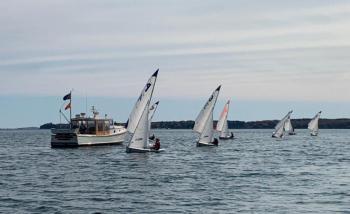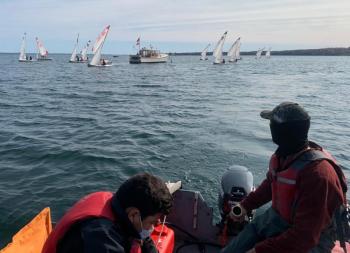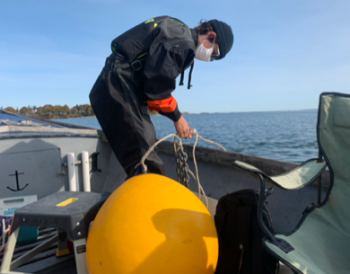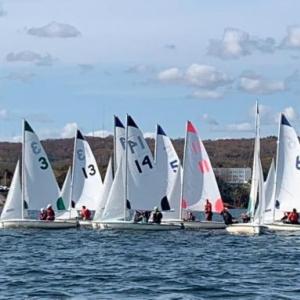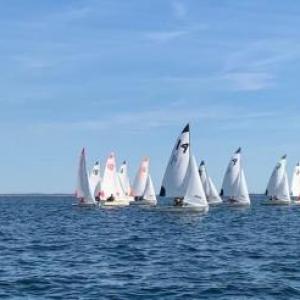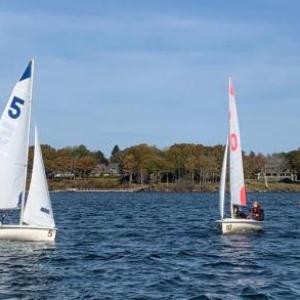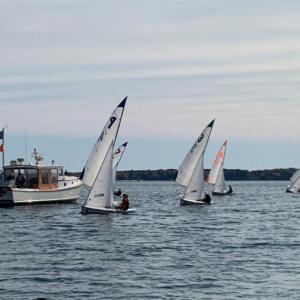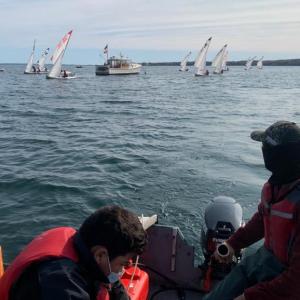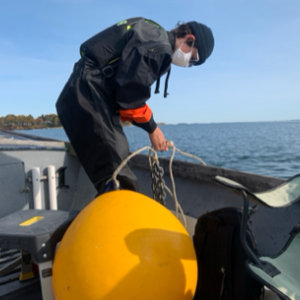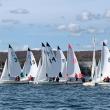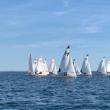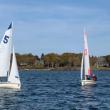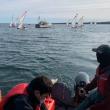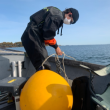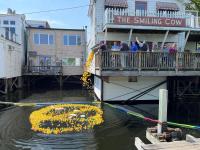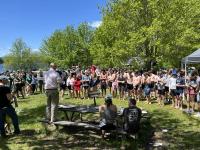Sailors delight in fall regatta at The Apprenticeshop
ROCKLAND — After a wet and blustery Saturday, the following sunshine and 5-9kt breeze was a welcome gift for sailors Sunday, Oct. 18 at The Apprenticeshop’s Pumpkin Spice Regatta.
Of the 12 racing dinghies available, not one was left at the dock as sailors got underway following a quick briefing by race official Peter Clapp, a longtime volunteer with the Rockland community sailing program.
The regular sailors included middle, high school, and homeschool students from Camden, Rockport, Rockland and Islesboro. The home teams were joined by sailors up from Boothbay Yacht Club, which has been providing an exceptional community sailing program for youth in that basin as well.
The Midcoast conglomerate of Rockland-Rockport-Camden fielded five boats, Islesboro three and Boothbay four. Coaches were able to have separate boats to help maintain social distancing and sailors dutifully kept masks on within six feet of one another.
Volunteer Ken Pride joined Clapp aboard his so-far-unscathed AESTIMARE, a well appointed Ralph Stanley lobster yacht. Not many would venture to have a dozen youth zipping around playing chicken with such a fine vessel, but Clapp is dedicated to the cause. Pride, a former Rockland schoolteacher who saw his own children participate in the program, plays a crucial role in helping set marks during bi-weekly practices and often brings COVID-friendly snacks to share at the end of tiring practices.
On Sunday, I rode along with Pat DiLalla, the lead coach for Rockland’s racers and part of the program for the past decade, who had offered use of his boat to help run the regatta. I am convinced that Pat is part spider and part bird for his unflinching willingness to take a spin in the tippy performance boats that measure less than 14 feet long, and his attention to wind shifts that borders on clairvoyance.
I had witnessed his acrobatics in stepping aboard to help haul lines tight or quell fears of newer sailors, but there is also the ever-present call of “HIIIKE!”, spurring on sailors to lean out (or ‘hike’) over the windward side of the boat to keep it flat and fast. This call usually happens so early into a shift of breeze that despite my several years of schooner and yacht work, I am still barely registering the subtleties that separate the winners in these boats and in these races. It can be learned, as I have started to learn the joy of coaching from Pat, but auditing practices in 2019 I was completely taken aback by how hyper-aware sailors must train their senses to be to guide these small and tender craft to victory.
Islesboro had their guru, Mike Horn, on the water as well. Horn has shouted above the wind in the rigging of sailors from Harvard for over 30 years, and that barely scratches the surface of his experience coaching sailors who went on as Olympians, as well as the fortunate youth of our Midcoast communities. His talents with the Islesboro sailors has led to a reputation for victory and fierce competition in the typical travel season of weekend regattas.
Representing Boothbay in ninja-like garb was sailing director Chris Liberti, who is also a teacher at Boothbay Region High School. Liberti has worked hard to keep the doors open at Boothbay through the pandemic and it showed in the performance of his sailors.
Immediately warm in their fall sailing gear, some sailors opted to dress down in the comfortable 62-degree air before getting out to the boats. Blue skies and a gentle easterly breeze with a touch of south started the first race, the horns on Clapp’s boat AESTIMARE sounding more like a freight train as 3 long blasts signaled the beginning of the 3 minute countdown sequence. Sailors paced along the start line, being careful not to go over early (by choice or pressure of their competitors) before the 5-4-3-2-1 blasts of the synchronized starting horns.
For the uninitiated, the action feels a bit like the crescendo of the opening track to Jaws. Although some of these sailors would compare it to ‘when the beat drops’ on a popular track. Sometimes I have to remember that at 31, I am older than dubstep, and if you didn’t get that joke, don’t worry about it and jump to the next paragraph.
Emerging from the melee that is the start of any boat race, boats 7 and 13 (both from Islesboro) pulled ahead sailing upwind to the first race mark. At the first mark, placed upwind of the start, sailors turn around and start to needle through or around their peers, flying past the start line and down to a mark equidistant below the start line from the windward mark. 13 maintained the lead but sailing downwind means someone can shadow you and essentially block wind from reaching your sails. It’s an equalizing factor that makes the lead boats still beholden to their pursuers. 11 (Boothbay) found solid position following 13 but was quickly followed and shadowed by 2 (Boothbay) and 4 (Rockland).
The shadowing tactic was becoming obsolete as the wind continued to shift clockwise and come more out of the south, a pattern that required mark shifts throughout the eight races of the day.
Additionally perplexing, was the unplanned elongation of the course. Set in the open water in the North side of Rockland’s harbor, out past the moorings; it was a perigean spring tide, with the new moon exacerbating the usual highs and lows. The extreme high was actually lifting our race mark buoys off the bottom and dragging the small and light anchors around.
Fortunately after 12:30 the tide turned and we were back on the bottom for most of the afternoon.
The breeze kept moving ‘right’ ESE, to SE, to SSE and adjustments were made accordingly. We raced a few courses that were twice around instead of once and the breeze stayed within a tolerable 5-9kts.
Sailors were warm and happy, and took a brief midday luncheon out on the water, letting the boats drift. Some pairs traded places to take turns as skipper and crew and the minimal substitutions to make sure fair participation were made.
No one capsized, and only one minor repair needed to be made on the water. Coaches and race committee alike noticed the tightening of the pack despite fatigue of sailors hiking and working their boats throughout the day. It was great to see everyone learning and getting more and more dialed in.
Overall standings at the end of the day showed Islesboro’s three boats in first, second and fifth. Boothbay’s boats took third and fourth.
The spring and fall seasons of youth sailing at The Apprenticeshop are eight weeks long, starting in early April and September, respectively. Spring is considered the varsity season, marked by colder water and windier conditions. Spring sailors are required to be in high school, should have previous sailing experience, and must have access to a drysuit. Fall sailors can be in middle school and do not need as much experience or a drysuit as the water is warmer and conditions not as harsh. The fall team keeps veteran spring sailors sharp and brings new sailors into a friendly environment to learn and grow as sailors.
Sailors from our programs have gone onto sailing programs and institutions at Maine Maritime Academy and the Naval Academy, won state championships, junior Olympics events, and even worked on windjammers, yachts, and fishing vessels.
Scholarships are available every season (spring, fall, and summer program) and new sailors are encouraged come and learn a life skill so strongly tied to our local history and culture. The lessons of dedication, attention to detail, coordination, strategy, empowerment, communication and leadership are tangible outcomes for participants under the guidance of highly capable coaches. For questions about youth sailing programs, adult sailing programs or boatbuilding programs, email info@apprenticeshop.org or call 594-1800.
Nate Hathaway is the Sailing Director for The Apprenticeshop in Rockland.
Event Date
Address
United States







